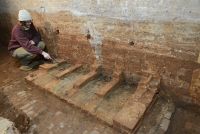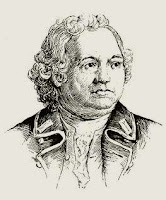The Other Author of “The Liberty Song”
The main author of that song, everyone agrees, was the Pennsylvania and Delaware lawyer John Dickinson. However, from the start Dickinson stated that the young Virginian Arthur Lee had “composed eight lines of it.”
That got me wondering how those two men collaborated. They didn’t live in the same colony, after all.
The answer seems to lie in Lee’s ambition to be involved in everything, which he shared with his brothers. He went to England for a top British education at Eton and then the University of Edinburgh to study medicine. After graduating in 1764, Lee went across the Channel to Leiden for another year of training. In same period he thrust himself into imperial politics, writing the pamphlet “An Essay in Vindication of the Continental Colonies of America.”
Lee came back to Virginia and set up a medical practice in Williamsburg. He ran into two problems. First, politics, both imperial and local, kept taking up his attention; he published a series of militant letters over the signature “Monitor” in William Rind’s Virginia Gazette in early 1768 and kept up the Lee family feud with the Mercers. Second, he just wasn’t that interested in medicine.
Meanwhile, in April 1768 Dickinson, now widely respected as author of The Farmer’s Letters, was trying to convince the merchants of Philadelphia to enter a non-importation pact, in the same way they had united against the Stamp Act three years before. Except those merchants didn’t want to. The debate in the newspapers pulled in Charles Thomson, Joseph Galloway—and young Dr. Arthur Lee from Williamsburg.
Lee declared in the 30 May Pennsylvania Chronicle that “the spirit of liberty is lukewarm in this powerful and important city.” [At least that’s what the Historical Society of Pennsylvania said in its 1895 edition of Dickinson’s papers. The newspaper database I use has no issues of the Chronicle from late May 1768 to confirm that.]
I don’t know if Lee visited Philadelphia before making that observation, but he was in the city the next month. That’s when he met Dickinson. Both men liked the idea of fighting the Townshend Act through a continental political movement, not just resistance from each colony. Lee appears to have brought the beginning of “The Liberty Song,” and Dickinson took up his invitation to collaborate.
Dickinson also took advantage of the young visitor’s presence by having Lee copy over an essay criticizing the Philadelphia mercantile community. Dickinson wanted to push the local merchants along, but didn’t want to make them resent him. So they pretended that essay came from Lee. It was published as “A Copy of a Letter from a Gentleman in Virginia to a Merchant in Philadelphia.”
By 6 July, Lee was back in Virginia, staying with George Washington at Mount Vernon. Shortly after that he sailed for London, where he took up the study of law. Eventually he became one of the U.S. of A.’s first diplomats.
Back in America, Lee’s older brother Richard Henry Lee maintained the connection to Dickinson, writing on 25 July: “From my brother, Dr. Lee, I have been informed of the kindness, with which you have expressed your willingness to begin a correspondence with me.”
The following year, Richard Henry Lee had Rind print Dickinson’s Farmer’s Letters and his little brother’s Monitor’s Letters in a single volume. He added a preface by himself and yet another version of “The Liberty Song.” Dickinson’s last and longest version of the song, published in the Pennsylvania Chronicle on 11 July 1768, had contained nine stanzas. The 1769 publication had five, four old and one new:
Here’s a health to our King, and the Nation at home,There’s no indication who composed those lines—Arthur Lee, John Dickinson, or perhaps even Richard Henry Lee.
AMERICA and BRITAIN should ever be one:
In liberty’s cause, we united shall stand
The envy and dread of each neighbouring land.
TOMORROW: A measure of the popularity of “The Liberty Song” in Boston.
















